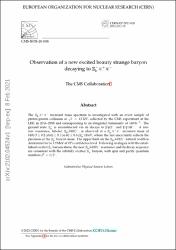Observation of a New Excited Beauty Strange Baryon Decaying to Ξ− b π + π −

Göster/
Erişim
info:eu-repo/semantics/openAccessTarih
2021Yazar
Sirunyan, A.M.Tumasyan, A.
Adam, W.
Ambrogi,F.
Bergauer, T.
Brandstetter, J.
Özdemir, Kadri
CMS Collaboration
Üst veri
Tüm öğe kaydını gösterKünye
Sirunyan, A. M., Tumasyan, A., Adam, W., Andrejkovic, J. W., Bergauer, T., Chatterjee, S., ... & Wang, H. (2021). Observation of a New Excited Beauty Strange Baryon Decaying to Ξ b− π+ π−. Physical Review Letters, 126(25), 252003, p.1-19.Özet
The Ξb-π+π- invariant mass spectrum is investigated with an event sample of proton-proton collisions at s=13 TeV, collected by the CMS experiment at the LHC in 2016-2018 and corresponding to an integrated luminosity of 140 fb-1. The ground state Ξb- is reconstructed via its decays to J/ψΞ- and J/ψΛK-. A narrow resonance, labeled Ξb(6100)-, is observed at a Ξb-π+π- invariant mass of 6100.3±0.2(stat)±0.1(syst)±0.6(Ξb-) MeV, where the last uncertainty reflects the precision of the Ξb- baryon mass. The upper limit on the Ξb(6100)- natural width is determined to be 1.9 MeV at 95% confidence level. The low Ξb(6100)- signal yield observed in data does not allow a measurement of the quantum numbers of the new state. However, following analogies with the established excited Ξc baryon states, the new Ξb(6100)- resonance and its decay sequence are consistent with the orbitally excited Ξb- baryon, with spin and parity quantum numbers JP=3/2-.
















